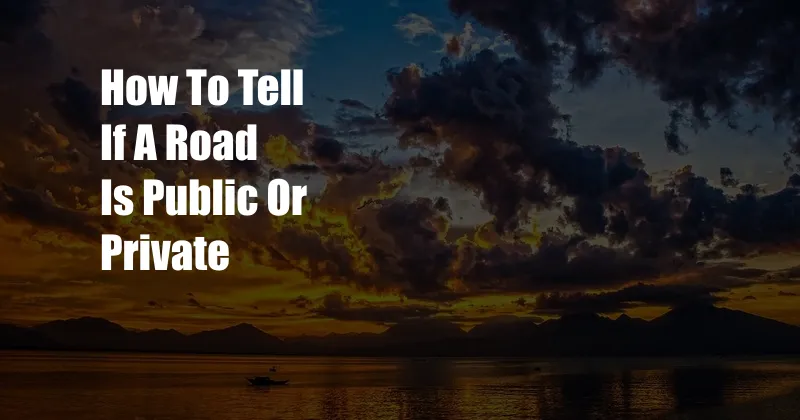
How to Determine the Public or Private Status of a Road
While exploring the countryside, I stumbled upon an unmarked road leading to an unknown destination. Curiosity got the better of me, and I ventured down its winding path. As I drove, I noticed a growing sense of seclusion. With no signs or markings, I couldn’t help but wonder if I had unknowingly trespassed onto private property. This experience sparked my interest in deciphering the often-unclear distinction between public and private roads.
The legal distinction between public and private roads is crucial for understanding property rights, access, and liability. Identifying the status of a road is not always straightforward, but certain key indicators can provide guidance.
Subtle Signs of Private Property
Private roads are typically marked with signs or gates indicating their private nature. These signs may state “Private Road” or “No Trespassing.” However, the absence of such signs does not necessarily imply that a road is public. Other subtle cues can also suggest private ownership, such as:
- Driveways and Cul-de-sacs: These are typically associated with private residences and businesses.
- Gates or Barriers: These restrict access and indicate private ownership.
- Posted Signs: Signs prohibiting trespassing, parking, or other activities may signify private property.
Historical Significance and Public Use
Roads that have been historically used by the public may acquire public status even if they are not formally designated as such. Public use can include activities such as:
- Vehicular Travel: Regular and open use by the public for driving.
- Pedestrian Access: Extended use by pedestrians for walking or jogging.
- Maintenance by Authorities: Public authorities such as municipalities or county governments may have historically maintained or improved the road.
Legal Presumptions and Dedications
In some jurisdictions, certain presumptions apply. For instance, roads that connect two public roads are often presumed to be public. Additionally, a landowner can dedicate a private road to public use by explicitly stating such intent in a legal document or through consistent public use.
Consultation with Local Authorities
If you are unsure about the status of a road, it is advisable to consult with local authorities. They can provide definitive information based on official records, surveys, or historical data. County or city offices, planning departments, or public works departments may have the necessary documentation.
Tips and Expert Advice
To avoid trespassing or other legal issues, it is always prudent to exercise caution when encountering unmarked roads. Here are some practical tips:
- Respect Private Property: Heed any signs or markings indicating private ownership and avoid trespassing.
- Observe Road Characteristics: Pay attention to signs of private property, such as cul-de-sacs, gates, or posted notices.
- Inquire with Locals: Ask residents or businesses in the area if they know the status of the road.
- Check Public Records: Consult with local government offices to access official records or maps that may provide information about road ownership.
Frequently Asked Questions
Q: Can a private road become public?
A: Yes, through dedication by the landowner or by public use and acceptance over an extended period.
Q: Who is responsible for maintaining public roads?
A: Typically, local governments or state highway departments are responsible for maintaining public roads.
Q: What are the consequences of trespassing on private property?
A: Trespassing is a violation of law and can result in fines, criminal charges, or civil liability.
Conclusion
Discerning between public and private roads can be critical for ensuring lawful access and avoiding property disputes. By paying attention to signs, road characteristics, historical use, and legal presumptions, you can make informed decisions about the status of roads you encounter. Consulting local authorities or seeking professional advice can provide further clarity. Understanding this distinction empowers you to navigate the roads with confidence and respect for property rights.
Are you interested in learning more about property rights and the implications of public and private roads? Share your thoughts and questions in the comments section below.